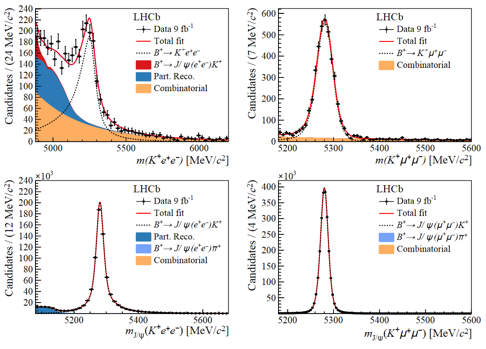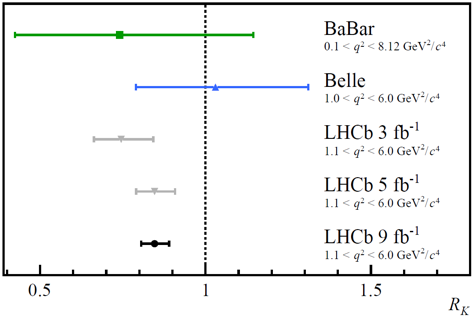Update of RK measurement
Today at the Rencontres de Moriond EW conference and at a seminar at CERN, the LHCb Collaboration presented an updated measurement of the ratio RK, an important test of a principle of the Standard Model of particle physics known as “lepton universality“. This principle states that the Standard Model treats the three charged leptons (electrons, muons and taus) identically, except for differences due to their different masses. An LHCb paper was submitted for publication today. The results indicate evidence for the breaking of lepton universality in beauty-quark decays, with a statistical significance of 3.1 standard deviations. “Evidence” is the term often used in the community for a result that surpasses 3 standard deviations but falls short of the 5 standard deviation level at which an “observation” is commonly claimed.
The ratio RK describes how often a B+ meson decays to a charged kaon and either a positive and a negatively charge muon (K+μ+μ–) or a positron-electron pair (K+e+e–). These decays are extremely rare, occurring at a rate of only one in two million B+ meson decays. The decays involve the transformation of a beauty quark into a strange quark (b→s), a process that is highly suppressed in the Standard Model and can be affected by the existence of new particles, which could have masses too high to be produced directly at the Large Hadron Collider. The left graph shows Standard Model contributions involving γ, W+, and Z0 bosons. The right one shows a possible new physics contribution to the decay with a hypothetical leptoquark (LQ) which, unlike the Standard Model bosons, could have different interaction strengths with the different types of leptons.
LHCb has studied a number of other such ratios comparing decays with different leptons in beauty particle decays (see RK, RK*0, R(D*), R(J/ψ) and RpK). These results revealed hints of deviations from lepton universality, none of which was statistically significant enough to constitute evidence of new physics on their own. However, according to theorists who study possible extensions of the Standard Model, these deviations combined suggest an interesting and coherent pattern. The previous measurement of RK used the LHCb Run 1 and the first part of Run 2 data set. The experimental method applied in today’s analysis is essentially identical but the analysis profits from additional data collected in 2017 and 2018. Measurements like RK apply a so-called blind analysis, in which the physicists analysing the data do not know the result until the analysis method is finalised and frozen, following an extended review within the collaboration.
To minimise the influence of detector and other experimental effects, LHCb physicists used a “double ratio” method, by measuring RK divided by another ratio, rJ/ψ. The rJ/ψ ratio is defined as the ratio of probabilities of a B+ decay to J/ψK+ with J/ψ →μ+μ– vs J/ψK+ with J/ψ →e+e–. The true value of the rJ/ψ ratio is predicted to be very close to 1, but it is affected by very similar detector effects as RK. This gives an extra layer of protection: the scientists study and correct for all known experimental effects, but if any unknown effects slip through they will cancel in the double ratio between RK and rJ/ψ. Moreover, J/ψ meson decays into μ+μ– and e+e– pairs are known to respect lepton universality at the 0.4% level. This means that the measurement of the single ratio, rJ/ψ, also constitutes an excellent cross-check, since it does not benefit from the double ratio’s cancellation of systematic effects and so is a sensitive and stringent test of the methods used to determine the efficiencies. The value of rJ/ψ is found to be 0.981±0.020, consistent with 1. The four figures above show the measured invariant mass distributions of B+ candidates for the four decay modes used in the double-ratio measurement, each with a clear accumulation of events around the B+ meson mass.
The analysis is performed in the range 1.1<q2<6.0 GeV2, where q2 is the invariant mass of the μ+μ– or e+e– pair. The value of RK is measured to be 0.846+0.044-0.041, and is shown in the figure to the left as a black point with error bars. This is the most precise measurement to date and is 3.1σ (3.1 standard deviations) away from the SM prediction, providing evidence for the violation of lepton universality. The previous measurements are shown on the plot as grey points with error bars. The newly measured value of RK supersedes previous LHCb results. Measurements by the BaBar and Belle collaborations are also shown.
This update is consistent with previous measurements, and with the improved precision the significance has increased past the three sigma level. This result will stimulate further intensive experimental and theoretical efforts. In the near future, LHCb will report on results from the decays of other beauty particles. These will be additional pieces in the puzzle of possible new physics.
Learn more in the LHCb Moriond presentation, in the LHCb CERN seminar, in the LHCb paper, in the CERN media update in English and in French, in the CERN Courier article and in the Conversation article; see also additional explanations by LHCb physicicts [1] and [2] and also follow a discussion.




